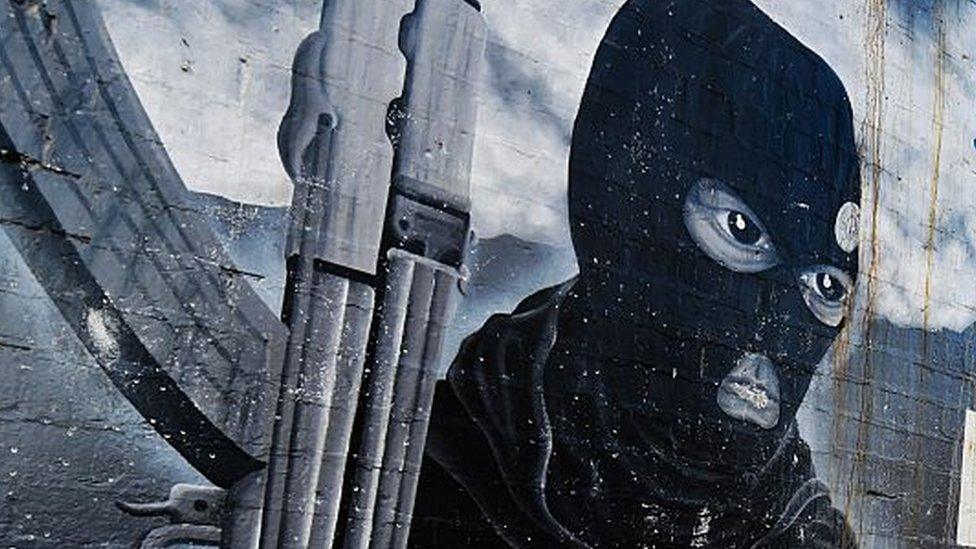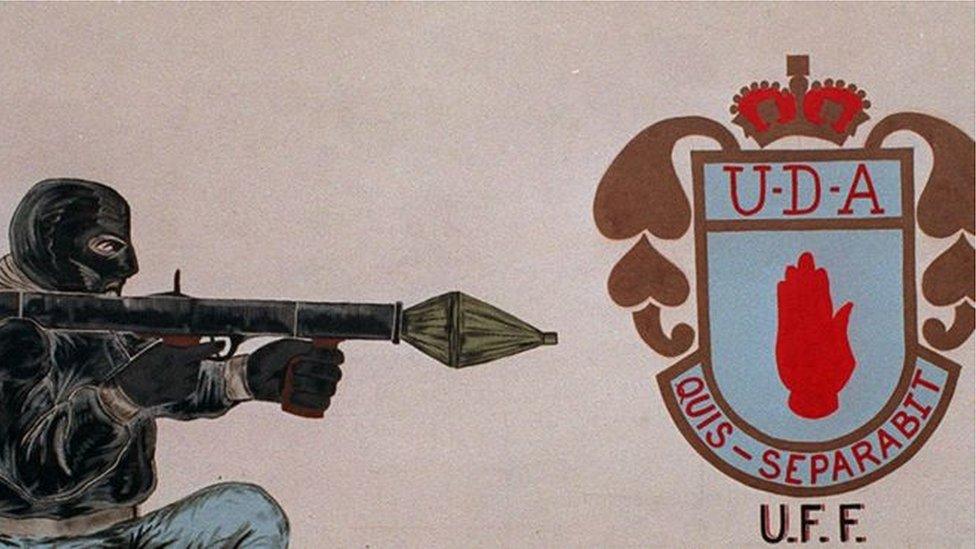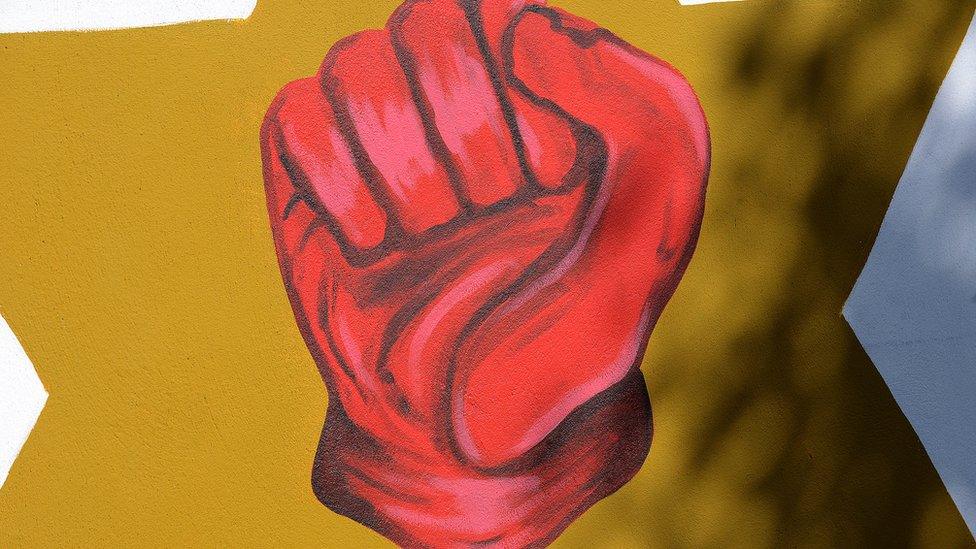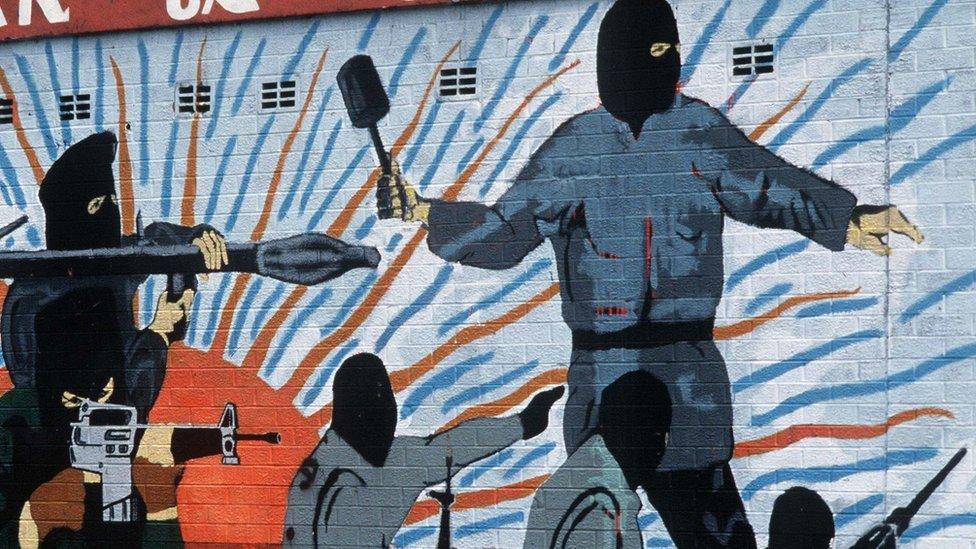Loyalist paramilitaries: Who are the groups in Northern Ireland?
- Published

Loyalist paramilitary groups have their origins in Northern Ireland's Troubles
Throughout Northern Ireland's Troubles a number of loyalist paramilitary groups were active and were responsible for hundreds of murders.
Many of the paramilitaries are now involved in criminality and drug-dealing, with tensions between and within groups resulting in serious disorder at times as well as shootings and other attacks.
The largest loyalist paramilitary groups throughout the Troubles were the Ulster Defence Association (UDA) and the Ulster Volunteer Force (UVF) and they remain the largest active groups.

The UDA killed hundreds of people during the Troubles in Northern Ireland and often claimed responsibility for sectarian murders using the cover name the Ulster Freedom Fighters (UFF)
What is the UDA?
The Ulster Defence Association, formed in 1971, had tens of thousands of members at its peak.
It killed hundreds of people during the Troubles in Northern Ireland and often claimed responsibility for sectarian murders using the cover name the Ulster Freedom Fighters (UFF).
The UDA remained a legal organisation until it was banned in August 1992.
Notorious attacks by the UFF included the shooting dead of five Catholics at a Belfast bookmakers in 1992 and the Greysteel massacre the following year.
The South East Antrim Ulster Defence Association is a standalone faction of the UDA and was once part of its inner council.
Security sources have previously said that with more than 2,000 members, it is one of Northern Ireland's largest paramilitary gangs.
According to an MI5/police intelligence assessment in 2021, the South East Antrim UDA"has access to arms and is heavily involved in drugs supply, community coercion, intimidation and other criminality".
In November 2007, the UDA issued a statement saying "the war is over".
It later said it had stood down the UFF and all UFF weapons were being put "beyond use", but that did not mean they would be decommissioned.
In 2018, the then PSNI Chief Constable George Hamilton said members of the UDA and UVF were still involved in organised crime.

The UVF was involved in many atrocities during the Troubles
What is the UVF?
The Ulster Volunteer Force murdered more than 500 people during the Troubles.
It was formed in 1966 and adopted the names and symbols of the original UVF, the movement founded in 1912 by Sir Edward Carson to fight against Irish home rule.
The UVF shot dead the first police officer to be murdered during the Troubles.
The organisation was later involved in various atrocities including the bombing of McGurk's Bar in Belfast, the sectarian killings of the Shankill Butchers and the Loughinisland massacre.
It sometimes claimed killings using the cover name the Protestant Action Force.
It has also been embroiled in feuds with other paramilitary organisations.
In recent years, it has been linked to serious criminality including drug dealing.
The East Belfast UVF is one of the major crime-dealing loyalist paramilitary organisations currently in operation and is among four loyalist factions being targeted by the Paramilitary Crime Task Force - the others being the South East Antrim UDA, the West Belfast UDA and North Antrim UDA.
What are the smaller groups?

Billy Wright was the founder of the LVF and was shot dead in the Maze prison in 1997
The Loyalist Volunteer Force was founded by Billy Wright, who was murdered in the Maze prison in December 1997.
He had been a prominent UVF member and was thought to have ordered or participated in about 20 killings.
As the peace process gathered pace in the 1990s, Wright resisted it and he was eventually expelled from the UVF and ordered to leave Northern Ireland.
Instead, in 1996, he founded the LVF.
It was banned by the government in June 1997 but it went on to murder a number of Catholics.
The LVF became the first paramilitary group to decommission any weapons late in 1998.
But the guns it handed in for destruction were old, and formed only a small part of its arsenal - the LVF remained armed and ready for violence.
It was involved in a feud with the UVF in the early 2000s.
In 2006, the Independent Monitoring Commission confirmed the feud was over, but said the LVF's involvement with organised crime and drugs continued.

Between 1966 and 1999 the UVF and the Red Hand Commando killed more than 500 people
The Red Hand Commando is affiliated with the UVF and is considered the most secretive of the loyalist paramilitary organisations.
It emerged in the early 1970s and according to research by Ulster University's CAIN project it killed 13 people including 12 civilians, although the number could be much higher.
Uniquely among loyalist paramilitaries it uses an Irish language motto.
In October 1994, alongside the UDA and UVF, the group was part of the combined Loyalist Military Command ceasefire.
The Red Hand Commando, along with the UDA and UVF, is represented on the Loyalist Communities Council, which was formed in 2015.
In 2017, it applied to the Home Office asking to be taken off the list of proscribed organisations.
Later that year, the then PSNI Chief Constable George Hamilton said groups like them should "simply go away".
Related topics
- Published2 December 2020
